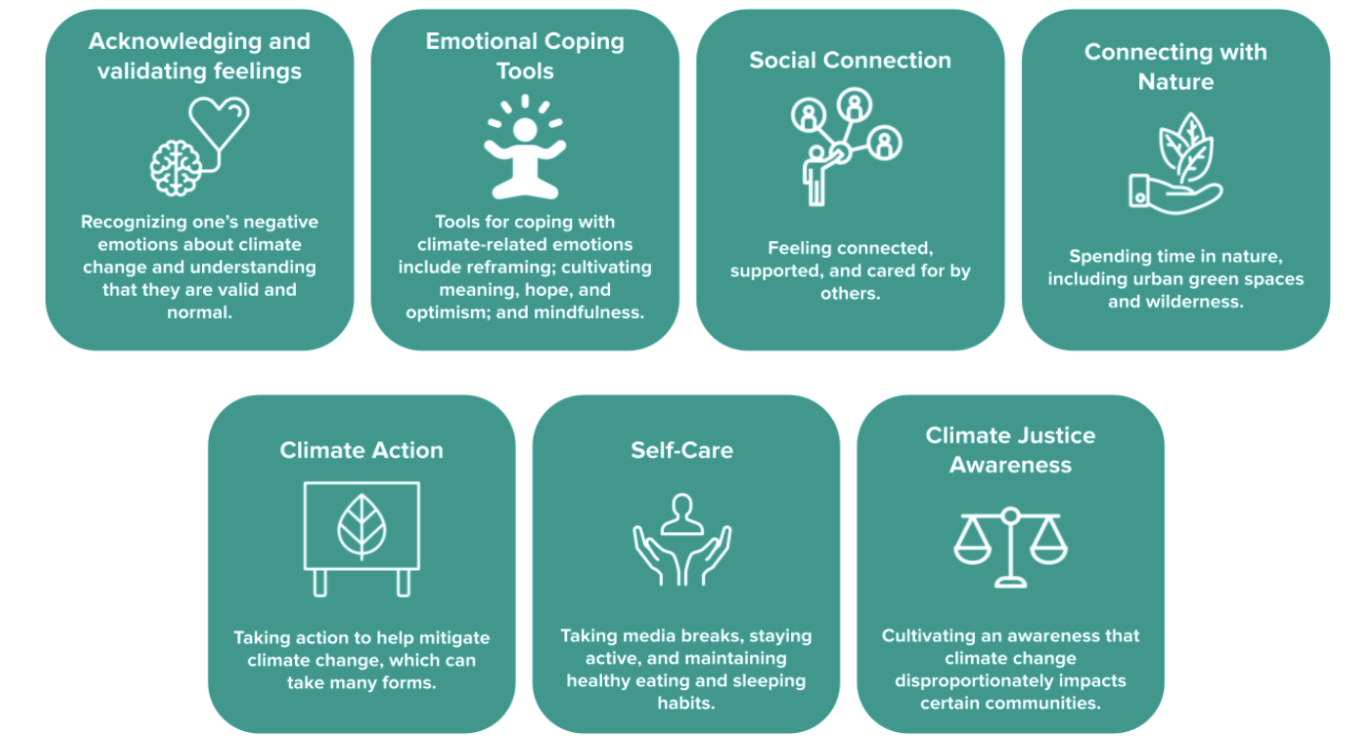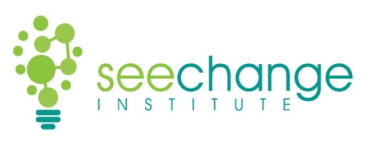Climate Change & Youth Mental Health
Psychological Impacts, Resilience Resources and Future Directions
Funded by Blue Shield of California, with support from the Climate Mental Health Network and Global Fund for Mental Health, this report: (1) synthesizes a decade of research on climate and mental health with a focus on youth and BIPOC, (2) shares a framework of the key components of climate resilience / anxiety interventions, and (3) highlights promising approaches in schools, families, communities, and clinical settings for climate anxiety support.
Background
Climate change is causing a maelstrom of disasters and environmental problems across the globe. In the U.S., the percentage of Americans who have been directly affected by climate change-related disasters is rapidly growing. The intense and stressful conditions of a major disaster can lead to significant and sometimes long-lasting impacts on mental health. Additionally, simply bearing witness to the negative impacts of climate change, or learning about how climate change is causing suffering to people and ecosystems around the globe, can lead to significant psychological suffering, including anxiety, grief, fear, anger, and guilt. Negative emotions about climate change are often referred to as “climate anxiety”, “eco-anxiety”, or “climate grief”.
Young people seem to be particularly vulnerable to the psychological impacts of climate change. For example, Blue Shield of California conducted the NextGen Climate survey in 1,200 youth ages 14-24 across the US, and found that 83% of respondents were concerned about the health of the planet, and 75% of the young people surveyed said that the issue has impacted their mental health.
Need & Approach
Given the findings from the NextGen Climate Survey suggesting that young people are suffering mental health impacts related to climate change, Blue Shield of California employed See Change to conduct a deep dive literature review and landscape assessment on the mental health impacts of climate change on youth. What is climate anxiety, and how prevalent is it among young people? Are certain groups, such as BIPOC youth and other historically marginalized groups, more vulnerable than others? What is being done about the problem, and what more needs to be done?
To approach these questions, we synthesized over a decade of research and theory on climate change and mental health, with a focus on youth and BIPOC groups. We supplemented this review with interviews with nearly a dozen leading researchers in the field, climate-aware mental health professionals, and educators. Additionally, we surveyed the landscape of existing resources and interventions – including community, educational, clinical, and media resources – that currently exist to support people struggling with climate anxiety, and investigated common components of these varied intervention approaches.

Findings
Our review of existing research indicated that climate anxiety is highly prevalent and becoming more widespread. Climate anxiety can range from mild to severe; for most people, distress about climate change is not a pathological condition, but rather a rational response to a real, existential threat. Additionally, young people seem to be particularly vulnerable to climate anxiety. Surveys examining concerns about climate change stratified by age have found that although distress about climate change is high among the general population, the prevalence is highest among young adults. A recent global survey of 10,000 youth ages 16-24 from ten countries found that 59% of adolescents and young adults reported feeling “very” or “extremely” worried about climate change, and over 45% reported that this worry interferes with their daily functioning.
Beyond age, a host of other factors can render people particularly vulnerable to climate change-related mental health impacts. Intuitively, people who have been more profoundly exposed or impacted by a climate disaster (e.g., lost a loved one, lost their home) are also at greatest risk for resulting mental health challenges. Too often, communities of color and low-income communities are the most exposed to climate disasters and thus the most vulnerable to resulting mental health impacts. The stress imposed by climate change also exacerbates pre-existing stressors in these communities, including poverty, systemic racism, and racial violence.
As awareness about the mental health impacts of climate change grows, resources and interventions designed for individuals suffering from climate anxiety are quickly proliferating, from community circles to outdoor hiking groups to climate-aware therapists. Yet, there remains a strong need for evidence-based interventions, as almost none of the existing resources have been evaluated for efficacy for climate anxiety specifically. However, the most promising intervention approaches are those that are based on empirically-supported strategies for coping with related issues, such as trauma, generalized anxiety disorder, and depression. In this report, we suggest that there are at least seven core strategies that are rooted in empirical research and represent promising approaches for addressing climate anxiety and grief. These core components are (1) acknowledging and validating feelings, (2) emotional coping tools, including reframing; cultivating meaning, hope, and optimism; and mindfulness, (3) social connection, (4) connecting with nature, (5) climate action, (6) self-care, and (7) climate justice awareness.
Access the Climate Mental Health Resource Library
Opportunities & Future Directions
In the realm of intervention work for supporting climate mental health and promoting resilience, much work remains to be done. We need intervention approaches that can meet the needs of individuals experiencing different levels of distress, and which can be applied not only in clinical settings (which are unaffordable, inaccessible, and/or stigmatizing for many groups), but can also be implemented more broadly in the community, in the classroom, and at home. The process involves developing theory-driven interventions based on empirically identified problems and solutions, followed by pilot testing with strong validity. Evaluation is key for improving interventions and maximizing effectiveness. Evaluation should not just investigate overall effectiveness, but look for potential differences in efficacy in distinct subgroups (e.g., racial/ethnic and age groups).
In the final section of the report, we identify gaps and opportunities in climate mental health research, focusing in particular on the need to understand racial/ethnic differences in the mental health impacts of climate change. We discuss opportunities for school- and family-based programs for supporting young people, as well as the expansion of community-based climate circles. Finally, we address the need for clinical training to better identify and support individuals with more severe distress and functional impairment.
Testimonials
Resource Library
Description and Purpose
The purpose of the “Climate Mental Health Resource Library” was to create a consolidated and more extensive list of climate mental health resources beyond what is detailed in the report narrative. The value of this user-friendly resource library is that it enables distinct users (or “actors”) with different interests and needs (individuals/young people, educators/educational institutions, caregivers/families, community groups, and mental health professionals) to conveniently identify resources available and relevant for their use. The database is sortable so that relevant resources can be easily identified.
Structure of the Resource Library
The Library is initially grouped by the resource name (column A), followed by a description (column B). The URL link(s) for each resource are hyperlinked in Column A and can be used to gather more information about each resource. Resources were organized into four resource types: (1) clinical, (2) community, (3) education, and (4) media, in line with our categorization in the report.
Each of the specific resources listed is particularly relevant or applicable to particular “actors” or users; this is indicated with a checkbox in Columns D through H. In some instances, resources may be used by multiple actors. For example, Project Inside Out, a media resource, is appropriate for all actors; whereas the Climate Crisis Hotline, a community resource, is most appropriate for individuals/youth and young adults. Columns I and J indicate the resource’s channel(s) and age/age range for which it is recommended or designed, respectively.
Using the Resource Library
The Google Sheet filtering function may be used to sort resources by user/actor or resource type. For example, a user (e.g., an educator) may be interested in seeing only those resources pertinent to teaching and education.
To achieve this:
(1) Click on the green filter icon on the upper right corner of the “Educator/Educational Institutions” header (box E1).
(2) Click on the “Filter by Values” field and click on “FALSE” to un-check that value (only “TRUE” should be checked).
(3) Click “OK”. Now, only the resources relevant to education are visible. To see all resources again, simply click on the green filter icon again, and under “Filter by Values” click “Select All”, and press “OK”. The same method can be used to sort by any actor/user in the spreadsheet (columns D through H).
To sort by resource type (column C), or any other column in the spreadsheet (D through J), click on the green filter icon and sort from A -> Z or using another sorting method of choice.
Share This Project
Intrigued? Let’s Chat!
